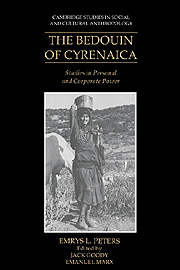Book contents
- Frontmatter
- Contents
- List of illustrations
- Foreword by Jack Goody
- Preface
- Introduction by Emanuel Marx
- 1 The Sanusi order and the Bedouin
- 2 The Bedouin way of life
- 3 The tied and the free
- 4 Aspects of the feud
- 5 Proliferation of segments
- 6 The power of shaikhs
- 7 Debt relationships
- 8 Family and marriage
- 9 Bridewealth
- 10 The status of women
- Notes
- Bibliography
- Index
- Cambridge Studies in Social and Cultural Anthropology
- Plate section
5 - Proliferation of segments
Published online by Cambridge University Press: 02 December 2009
- Frontmatter
- Contents
- List of illustrations
- Foreword by Jack Goody
- Preface
- Introduction by Emanuel Marx
- 1 The Sanusi order and the Bedouin
- 2 The Bedouin way of life
- 3 The tied and the free
- 4 Aspects of the feud
- 5 Proliferation of segments
- 6 The power of shaikhs
- 7 Debt relationships
- 8 Family and marriage
- 9 Bridewealth
- 10 The status of women
- Notes
- Bibliography
- Index
- Cambridge Studies in Social and Cultural Anthropology
- Plate section
Summary
In this chapter I do not propose to discuss the genealogies of the Cyrenaican Bedouin in full, but only such aspects of them as are strictly relevant to an understanding of their process of growth. Many other aspects of these genealogies will be referred to, and indeed, some of the arguments put forward will presume an acceptance of views which cannot be developed adequately in this chapter.
The Bedouin of Cyrenaica claim that they are all descendants of a unique ancestress, Saʿada. Writers in the past (e.g. Smith 1903) have considered the occurrence of female names in patrilineal genealogies as evidence of an earlier and matrilineal mode of descent. A more satisfactory explanation of the occurrence of female names is to be found in the combination of two facts; firstly descent in the patriline, whether or not male names are used, is assumed; and secondly the Bedouin are polygamous. If, then, half-brother differentiation or full sibling unity is to be shown genealogically, the obvious way in which this can be done is to use a maternal name in the genealogy. Thus, in the Cyrenaican genealogy, a number of tribal groups will be shown as sons of a particular father. If differentiation of these groups needs to be shown, this can be effected by clustering the groups round, say, two female names (the names of the respective mothers) thereby making the two clusters of groups stand in the relationship of paternal half brothers.
- Type
- Chapter
- Information
- The Bedouin of CyrenaicaStudies in Personal and Corporate Power, pp. 84 - 111Publisher: Cambridge University PressPrint publication year: 1991



